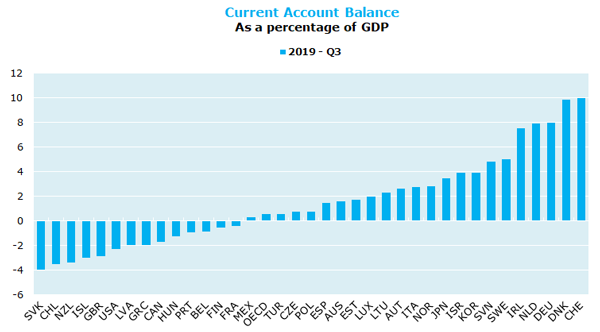International trade and balance of payments statistics
Quarterly balance of payments statistics
Balance of payments statistics record economic transactions between residents and non-residents. They provide a series of balances between inward and outward transitions and show how these flows of transactions are funded. The balance of payments is an important set of macro-economic statistics for a country, describing its economic and financial relationships with the Rest of the World.
The OECD collects and disseminates balance of payments statistics for all OECD countries, the major emerging economies and key aggregates e.g. the OECD total, G7. Data are collected for all the major balances, inflows and outflows in the current, capital and financial accounts. The current account components are also presented seasonally adjusted. In most cases time series start in 1995. The OECD works closely with national agencies in countries to ensure both the quality and the timeliness of the balance of payments statistics supplied and disseminated.
Finding the data
Access the quarterly balance of payments database:
- Quarterly balance of payments
- Current account balance as a % of GDP
- Balance on goods
- Balance on services
- Financial account
The OECD cooperates closely with the statistical office of the European Union (Eurostat) and the European Central Bank (ECB) to collect balance of payments statistics from EU countries as well as the Euro Area and European Union aggregates.
The balance of payments current account, an essential macroeconomic statistic
A country’s current account balance as a percentage of its gross domestic product (GDP) is an important economic indicator. It shows whether the country is a net exporter or importer and therefore whether the country needs to finance a current account deficit or is running a balance of payments financial surplus. Putting the current account balance in terms of GDP provides an understanding of the longer term sustainability of the balance, in particular if the country is running ongoing deficits.

Source: OECD, Balance of Payments (MEI) BPM6, Current account balance as a % of GDP
Finding related data
The balance of payments is a framework allowing the user to understand how the individual accounts balance and interact at the economy level. However, each account is a major economic statistic itself providing the user with valuable information about its sphere of activity. In some cases, the subject has its own methodology (harmonised with the balance of payments methodology) and an extensive range of additional statistics at a detailed level.
- Foreign direct investment (FDI) statistics
- International merchandise trade statistics
- International trade in services
Further reading
Countries compile and disseminate balance of payments statistics according to the IMF's Balance of Payments and International Investment Position Manual, Sixth Edition (BPM6). The widespread adoption of BPM6 by countries has ensured good international comparability of the data and enabled meaningful cross-country assessments and country economic evaluations. The move from the previous manual (BPM5) to BPM6, amongst other changes, included a stricter application of the ownership principle with the purpose of better capturing and measuring total global production and global value chains.
- Balance of Payments and International Investment Position Manual, Sixth Edition (BPM6)
- The IMF's FAQs on Conversion from BPM5 to BPM6
Contact
For any queries about balance of payments at the OECD, please write to: stat.contact@oecd.org
Related Documents